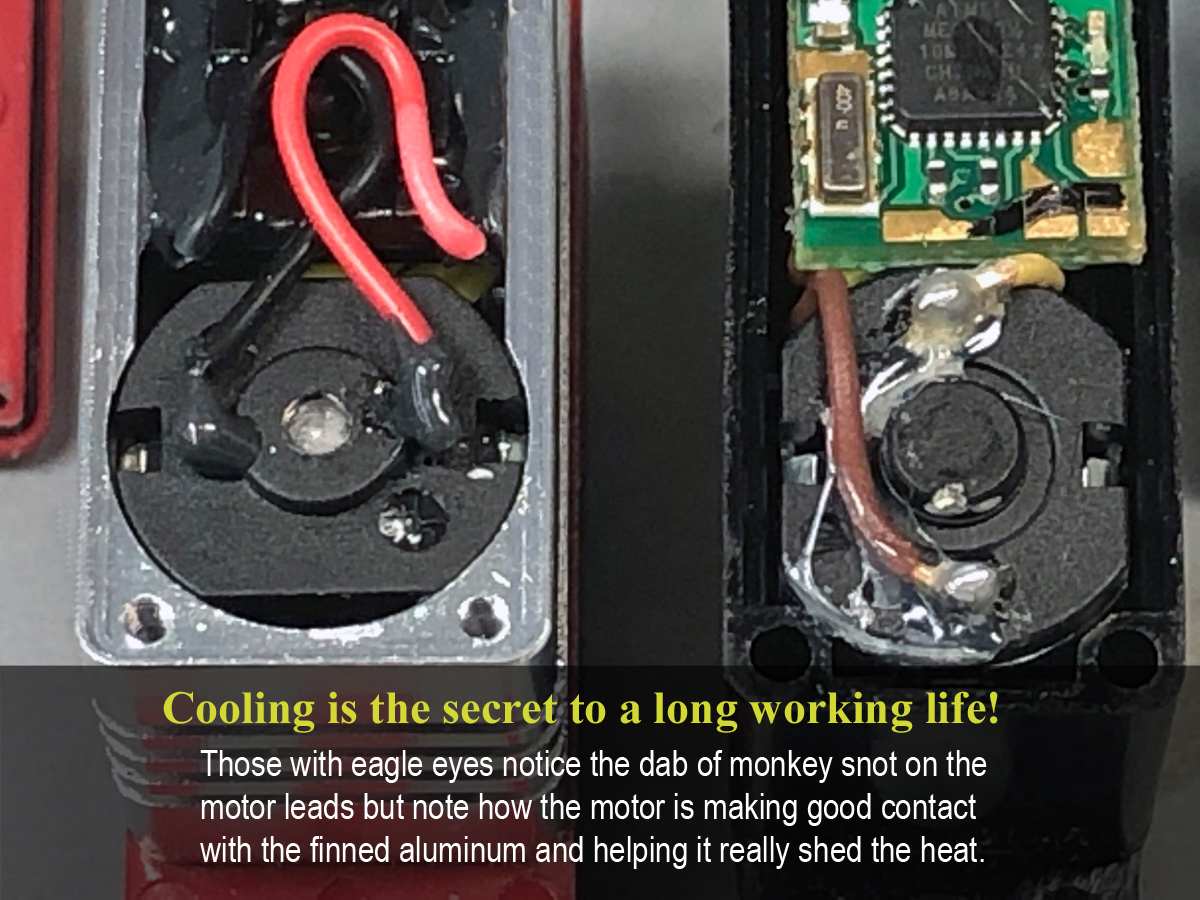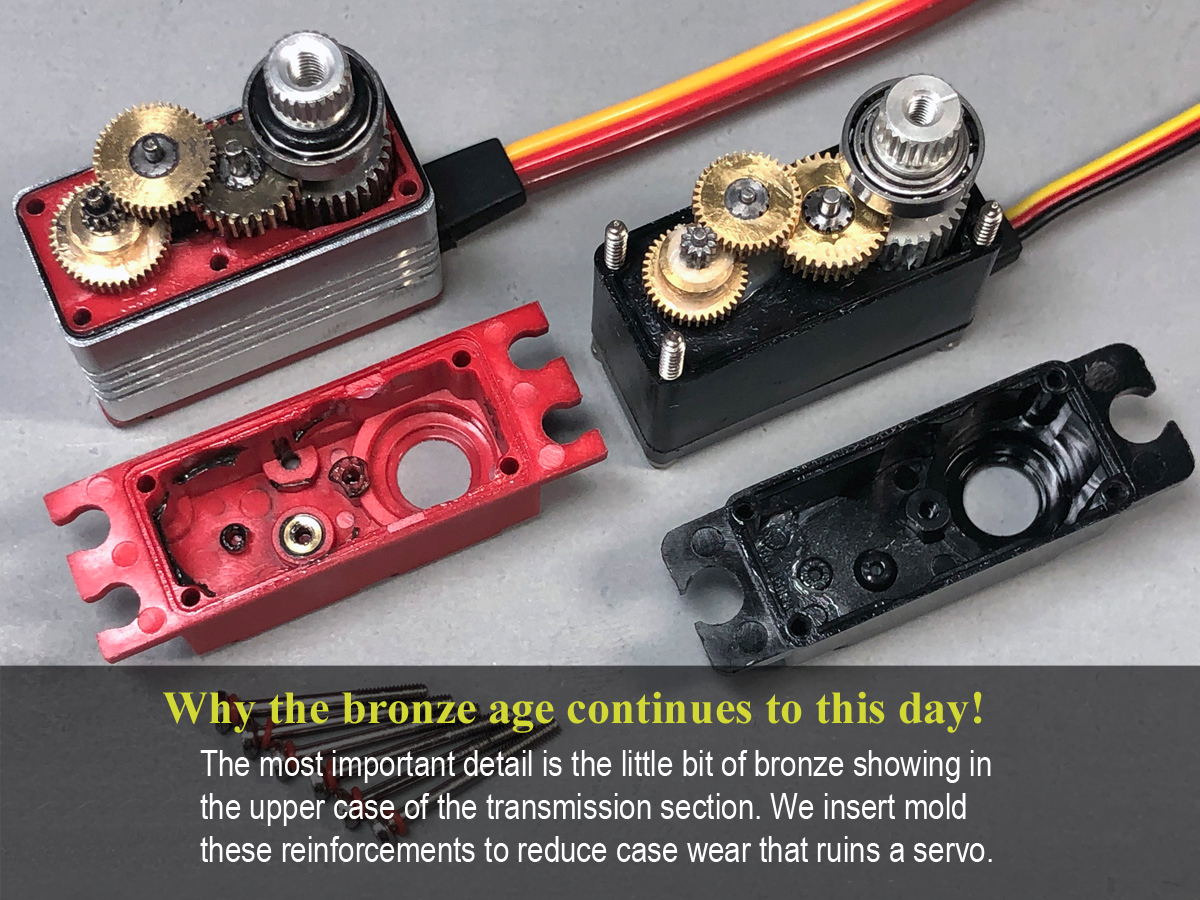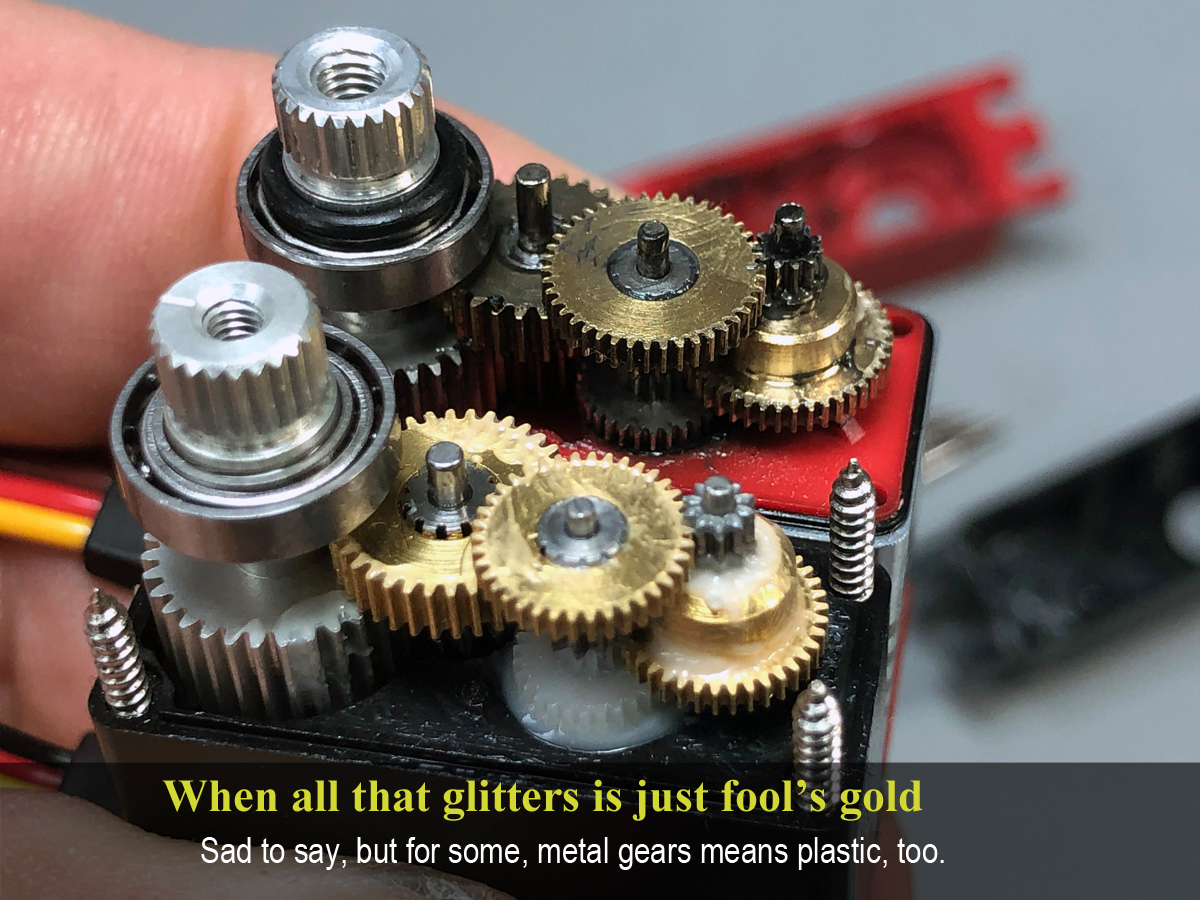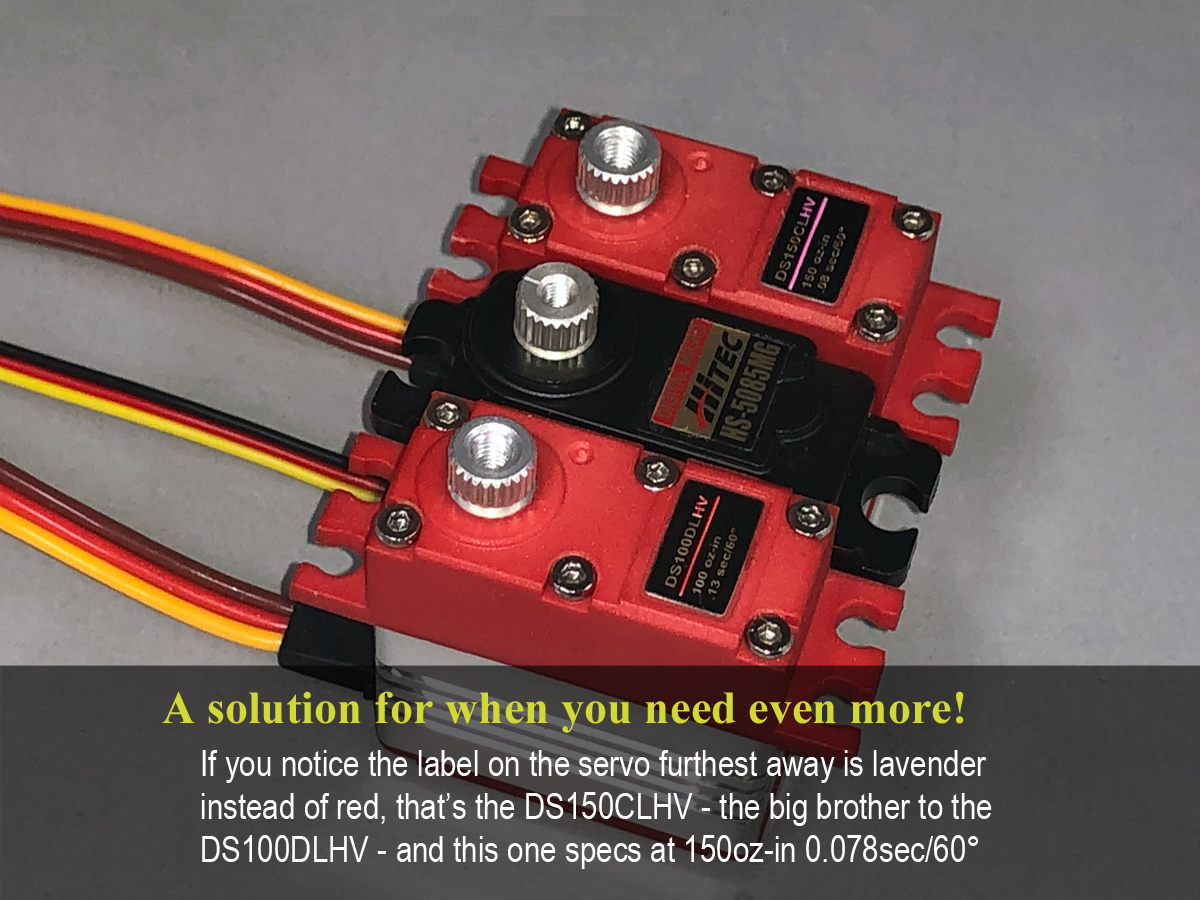No time to read all this? Eyeball the TL;DR tab, then add the servos to your cart! Want to see these servos in action? Follow this link for an independent review of them in Doc Austin's 52" Extra model airplane: https://tinyurl.com/ybxlbj3x
Background:
We're modelers and have lost count of how many planes we've equipped with the top selling digital-servo in the micro class, Hitec's HS-5085MG (beginning, in fact, with the old analog HS85, and more recently, the high voltage version, the HS-5087MH).
Thing is, with use these Hitec servos (all of them) begin to show increased backlash in the gears. And if you use them hard it happens fast! As it turns out, this isn't so much due to the gears themselves wearing out because what really happens is the case is built so lightly it flexes and wears. This results in degraded gear alignment. This, largely because the pockets in which the steel gear shafts fit deform due to the loads (they go egg-shaped). Of course, sloppy gear shaft bore makes it impossible to maintain proper gear alignment so once the gear shaft pockets lose tolerance and gear mesh goes to Hell, you're way down the road of accelerated gear wear (meaning all bets are off).
Making things worse, the Hitec micro servo is fitted with just one ball bearing instead of two and consequently, by the time folks notice excess backlash in their servo it's probably too late to repair economically. Sadly, a lot of guys opt to buy replacement gears without also buying a new case meaning they'll soon be right back where they started because they didn't address the root cause of the problem. And none of this matter in certain applications (for example, flying 3D model airplanes) because to be fair, this is partly a problem of our own making, e.g. we're pushing them too hard. Why? It's because we're using this micro servo in applications Hitec engineers never envisioned!
Fortunately there's a solution. We've re-thought the micro servo by taking into account what modelers are demanding from the micro servo form-factor these days. For that matter, so has Hitec, but they can toot their own horn because we're here to tell you what we have that's better - the DS100DLHV - and how we offer it for the same money!
Improvements:
At ProModeler we began with a clean sheet of paper (a metaphor for our CAD workstation displaying a blank SolidWorks screen) and this servo, our DS100DLHV is our best effort at knocking the king off its perch. Do we succeed? Well, that's up to you to decide, but here's why it may become the go-to micro for your next project.
To recap, since the basic design has been around forever, we sensed an opportunity and decided to have a go at building a better servo for this class (micro). Obvious areas for improvement included addressing an overly flexible case, improved/reinforced gear shaft pockets, adding vibration protection, improving motor cooling, improving the gears themselves, going from one to two ball bearings, plus a more capable servo lead, and niceties like water resistance. In fact, no detail was so small as to escape our attention because we even addressed the screw securing the servo arm to the splined output shaft!

Things to note in the above photo (beyond both being pretty much the same size) is that while the DS100DLHV micro drops right into the same mount as a Hitec HS-5085MG, because it's nearly twice as powerful it uses four mounting-screws instead of two. This isn't a big deal, of course, since a drop of CA plus a toothpick fills the hole where Hitec mounting screws lived. Trim flush with an X-Acto and presto, the mounting rails of your model are ready to be drilled for new servos! Now the servo doesn't rock on its mount as easily during hard use meaning the pilot feels a more direct sense of being connected, which is something even an average pilot can feel.

Water resistance:
An important improvement wasn't due to modelers clamoring for it but was required by our primary customer. Basically, our having to meet MIL-STD delivers a water resistance benefit for modelers. Specifically, those of you flying nitro-powered helicopters and airplanes benefit because absent the o-rings we use to seal the servo against environmental contaminants, fuel and exhaust oil may seep into the control-electronics and short out a servo - not good! Other modelers benefiting from water resistance include those using this class of servo to control differential lockers and transmissions on trucks that get wet and muddy. Then there are those flying float planes (a great pastime) and thus, water resistance turns out to be a pretty good thing for all modelers! Especially because any of us may experience a pop-up summer rain shower that drenches you and your model before you can land and take cover!

The critical point when looking at the above photo is the tiny pocket. It's the one sized for the itty-bitty o-ring because its tolerance is measured to the ten-thousandths, which is technically quite difficult. Basically, molding to such great precision is no walk in the park because otherwise the special socket cap screw head can't close over the top of the o-ring, squeeze it just the perfect amount, and compress it such that it seals the servo. If it were easy everybody would do it. They don't, and this is part of why this servo meets;
MIL-STD-810G-Part 16
- Shock - Test Method 516.6
- Vibration - Test Method 514.6
- Water Intrusion - Test Method 514.5
Don't give a flip regarding water resistance? Guess what? You get it as part of the deal.

Electronics:
Once you remove the electronics cover from both servos, they look pretty similar, e.g. there's a motor, PCB, four screws, rubber pigtail for the lead. But there's more to see.

Note; in the above photo, did you notice how long the Hitec screws actually are? That's because they pass through both the servo electronics cover, plus the center case, before finally threading into the transmission case (in plastic). The whole thing is relatively flexible, which plays a role in gear life. Conversely, the screws securing the ProModeler electronics cover are very short because they thread directly into aluminum and their only job is to secure that one cover - nothing else - so they can be really small.
In the closeup photo below, one of the first thing you notice is you can't clearly see the ProModeler printed circuit board (PCB) but the Hitec's is easy to discern including the components. It's not that we're camouflaging ours, but instead it's because we coat it for protection. The glossy black stuff we use isn't found in the world of consumer electronics because they don't require the level protection it affords. However, when it comes to meeting military and NASA requirements for vibration protection it's another story - they both require what's called a conformal coating.

Note, in the trade it's also called potting compound - but we refer to it as monkey snot! Why is this? Ever had a booger you couldn't flick off your finger? Same with this stuff, and because it's such a sticky mess to deal with we took to calling it that. So why do we bother when it's such a pain in the ass to apply and the other guys don't feel the need? Especially for servos meant for models? In part it's because this is what it takes for the servos to meet MIL-STDS; Test Method 514.6 - Vibration, which we must comply with. That, and we're building the best servo we can regardless of whether the customer is military, an agricultural-oriented UAS, a university, or you - a civilian user. Everybody gets our best effort!
Basically, damaging vibrations come from many sources. With respect to models, these typically include an out of balance spinner, props that may have kissed the asphalt, even wheels a little too loose on an axle. All can generate vibrations that feed back through the airframe and into the control electronics. The way a conformal coating works is quite simple because all it does is flow in between the delicate surface mount components then once it sets up, encases them to protects the entire PCB against bad ju-ju!
Anyway, in the close up photo below, notice how we also apply a bit of monkey snot to the motor leads, but what you should really be looking at is the tight fit between the motor's can (the outer metal shell) and the finned aluminum center section. Our goal is for it to touch as much aluminum as possible because it promotes heat transfer. An air gap doesn't help and plastic, being an insulator, really sucks (you don't need to be a rocket scientist to know aluminum is night and day better at keeping the motor cool).

Bottom line? Better cooling is really important. Especially because maneuvers like Harrier Rolls - where the servo is constantly moving and swinging through large deflection angles - create a lot of heat in the process. Better cooling is a big deal!
Before moving on; notice the tiny hole in the end of our motor? You can ignore it, but if once every year or two you go to the trouble of dipping the tip of a toothpick in ultralight machine oil and apply a tiny bit right there you'll promote longer motor life because it seeps into the motor and helps lube the bearings. Do you have to do this? No, absolutely not, but the pros amongst you will take note and add it to your maintenance schedule for the off season, e.g. when it's too cold to fly.

Gear train:
In the photo below most folk's eyes are drawn to the gear train. Some may wonder why we use 6-bolts versus 4-screws to secure the transmission section to the center case. This is actually pretty important and it has everything to do with increased rigidity, which improves gear mesh. To begin, the aluminum center case is FAR stiffer than a plastic version. Added to which, our components interlock so they can't just slide once they come into position - this happens with the all-plastic design. Plus, the fine-threads of a machine bolt provide a lot more clamping force than a coarse-thread screw. Added to which, threading into aluminum is much stronger than threading into plastic.

So a more rigid case translates directly to better gear mesh because it doesn't flex like a plastic case does. End result? A significantly tighter gear mesh with a working life measured in decades instead of years! But even more important than the gears themselves, take note of the bronze insert visible in the above photo. It's the shiny bit of bronze just visible within the red polymer case top.
This bronze reinforcement is where the forces are greatest (after the output shaft itself) and this little bit of bronze is critical for long gear life. Why? It's because a plastic hole becomes egg-shaped quickly due to the loads, which leads to poor gear mesh. Worse, by the time someone notices the servo's gears are a little sloppy and orders replacements, they've probably pissed away their money unless they're also replacing the case. Many overlook case wear and thus, the problem of gear wear actually derives from case wear at the gear shaft pockets. Reinforcing this pocket with a bronze insert short circuits this! But insert molding is expensive, likely explaining why the other guys don't do it for this class of servo, which is too bad because it's such a nice improvement!
Another step we take is making the remaining plastic pockets stronger. How? By making them deeper and using a slightly longer shaft. Basically, we're spreading the loads better, which effectively makes things stronger! You can just see this by eyeballing how much shaft sticks out of the individual gears. Notice how our shafts protrude about twice as much as theirs do. Doubling the area is effective and doesn't cost much. Moreover, it's really easy and reduces working pressure by about 50% thereby greatly extending the working life. This really isn't rocket science; it's more a matter of common sense!
Another area of improvement is in the number of ball bearings supporting the splined output gear. The Hitec uses one, our servo uses two! How important is this? It's a huge improvement because this plays a significant role in why the Hitec servo wears out so fast. Our way doubles the bearing cost but without question results in a better servo.
Finally, before we move on, notice the thin black line around the red polymer section (the red piece just above the aluminum center case). This is yet another o-ring. This one is fully captured also (meaning you won't see it unless you take the servo apart) and once again, it's there to protect your investment against liquid and dust intrusion. BTW, notice the fat o-ring sitting at the base of the splined output shaft. It seals that part of your servo case. Once again, these are small details costing pennies but if we can be said to have a philosophy it's this; take care of the small details and the big picture takes care of itself.
Now let's take a really close look at the gear train with the close up photo below. First thing to notice is Hitec refers to their servo as an MG, which modelers naturally interpret as metal gears. Thing is, if you look closely, the white gear is actually made of plastic! Moreover, they sell these in packs of 3. Take a moment and consider the implications!

But there's more to examine in this photo. Like the coarse screws sticking up from the corners of their servo. These thread into plastic, and after you disassemble a servo once or twice the threads in the plastic becomes weaker and prone to stripping.
Bottom line? While we never build to a price point, neither do we say cost is no object, but in creating the DL100DLHV accounting had no say whatsoever. Our goal was quite simple; address every weak point in the Hitec product, make a better servo and offer it at the same price point. You may wonder if this is a result of a better business model, better engineering, or some intangible but in truth, we just want to earn your business!

Conclusion:
Finding areas to improve on the out of date design proved remarkably easy. These included making the case more rigid to enhance gear mesh, an aluminum center section for better motor cooling, bronze inserts for longer gear shaft pocket life, longer gear shafts to reduce working pressure, added water resistance, reduced case flex by interlocking the assemblies, doubling the number of ball bearings, improving the clamping force of the fasteners by using fine thread Allen head machine bolts, improved vibration protection via a conformal coating, and spacing the mounting screws further apart to reduce the rocking tendency when a servo deflects under load. We even addressed little things like using a common-as-dirt M3 machine screw to secure the servo arm because if you misplace one, they're more readily available!
Offering this servo for the same price is the icing on the cake. This is us trying really hard to earn your business. We believe your decision to use our micro servos for your next project will be a no-brainer, but we also recognize there are folks that have had good success with Hitec micro servos and nothing we say or do will make them switch. It is what it is, but comedian Ron White has a funny line that may apply.
Naturally, this brings us to the question; who offers you the most bang for the buck? We set out to make the best servo in the class by addressing every single product weakness we could identify. And by no means do we wish to imply theirs is a bad servo because it's not. Instead, we've just tried to give you more for your money. Did we succeed?

Bottom line? The DS100DLHV is a 333Hz, micro-size high voltage (HV) digital servo built on a center case CNC-machined from a solid billet of 6061-T6 aircraft aluminum. It's equipped with dual ball bearings, and metal gears, specs at 100 oz-in 0.13sec/60°. It uses MIL-SPEC components, meets MIL-STDS, has a million-cycle potentiometer and quite simply, it's the best we can offer unless you want more torque/faster speed 'and' are willing to pony up for it in which case we refer you to either our DS150CLHV (built on the same case) or DS145CLHC (an all aluminum case) but be warned, bring your wallet!

Want more information? Clicking on these tabs leads to further details.
- Specs - useful if you're curious about the raw numbers, dimensions, etc.
- Comparison - we did the homework for you as we spotlight competitors specs
- TL;DR - we cut to the chase with a few photos and the facts!
- Reviews - short and sweet with real names and places - no BS.

Getting down into the weeds:
If you've been around since the Earth cooled and recall how back in the day (in the times when companies named Kraft and Orbit dominated), whenever a servo developed the jitters or wouldn't center quite as well as it used to, you merely disassembled the servo, removed a screw to open the potentiometer, and cleaned it with a cotton swab and alcohol. These days you can't because the pots are ultrasonically welded meaning they can't be serviced. The point is; manufacturers (Hitec, Spektrum, Futaba, et al) force you to send your servos in for service. We don't because replacing a potentiometer is an easy job. Many modelers are perfectly competent to do it themselves because it only involves three small solder joints. So if you're even half-way handy that way, we're happy to offer you just the potentiometers so you may DIY instead, and save money.
Soldering not your forte? No problem, send your servo to us and we'll be happy to do it for you but just bear in mind, our being unique in offering individual replacement parts (beyond the usual fare) may save you a fair bit of coin. Especially if you're a competition pilot and replace pots yearly or semi-yearly - pros take note. Finally, we use the very best million-cycle Nobel (Japan) potentiometers money can buy . . . but they're still a wear item. Just
saying.
Ownership Considerations:
Competition pilots - especially those who fly precise maneuvers favor ProModeler servos because they center better. This is because we use MIL-SPEC components (plus a genuine Japanese Nobel-brand potentiometer). The other guys? They're satisfied with a cheap clone potentiometer, one of the new magnetic/
inductive pickup, or some other cost saving variation of a potentiometer.
Specifically with respect to potentiometers, we're often asked why we don't move to newer technology? Especially because magnetic/inductive pots are 1/4th the price of our million-cycle Nobel pots. In part it's because a pot with a carbon wiper has been around a long lone time for a reason, e.g. it works! The reason we stick with what works has everything to do with how each type of potentiometer fails.
Our Nobel potentiometer gives you plenty of warning it's reaching end of life because it may twitch in certain places, or jitter a little bit around neutral, or perhaps it doesn't return to neutral quite as crisply as it once did. Thing is, with the magnetic/inductive types, they just up and quit - failing suddenly more like a light bulb. Reflecting on this; which failure mode would you rather experience? Especially while flying!
For us it's a no-brainer because we're modelers like you - meaning we go fly on weekends also. Thus, we think our design decision of sticking with the tried and proven potentiometer is not even up for discussion . . . but it's 'your' model so you decide which technology you'd rather trust.
Also, and this is important for IMAC and pattern competitors because you fly a lot and thus, have to go through and R&R your servos each winter. Why do we place such an emphasis on competition pilots? It's because these pilots are really, really dedicated. By this we mean they fly maybe 30-50 times a week (and they do it week-in, and week-out). Basically, it's de rigueur for them to practice 3X a week plus 2X more on weekends. Believe me, that's a lot of flying and thus, pros know potentiometers, even million-cycle ones like we use, are a wear item.
Since replacing a potentiometer is easy (a matter of three solder joints) pros find our attitude toward offering electronic-spares in addition to mechanical-spares like gears, cases, etc. refreshing. So should you (even if you're never going to open a servo and service it yourself).
Bottom line? Full spares support is a requirement of military contracts but a game changer in the world of civilian-use servos!

Note:
These are tiny servos with even tinier gears and operating them manually via the servo horn may damage them. This damage is not covered by warranty. Please do not treat these like a standard size servos. You've been warned. Also, operating voltage is 4.8-8.4V, but optimal performance is obtained with a 2S LiPo instead of a BEC. This is because LiPos deliver the required current without voltage spikes, noise, or otherwise adversely affecting the delicate avionics (15C or better is recommended). After all, synthetic orange colored Tang may have gone to the moon, but it doesn't compare to freshly squeezed orange juice. Same thing when it comes to feeding your avionics!